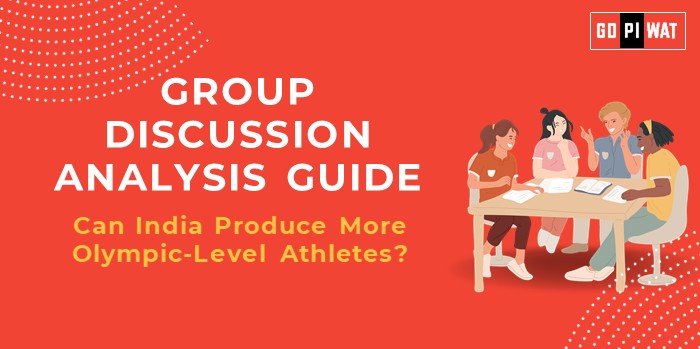📋 Group Discussion (GD) Analysis Guide: Can India Produce More Olympic-Level Athletes?
🌐 Introduction to the Topic
- 🏋️ Opening Context: Sports development is a critical component of national pride and economic growth. India’s recent Olympic performances have shown improvement, yet the country’s overall medal tally remains limited compared to nations like the USA and China.
- 📜 Topic Background: India’s sports ecosystem has evolved significantly over the past decade, with increased funding, better infrastructure, and initiatives like Khelo India. However, achieving global dominance requires systemic changes across grassroots development, infrastructure, and athlete support.
📊 Quick Facts and Key Statistics
• 🏅 Olympic Medals (Tokyo 2020): India won 7 medals, its highest ever.
• 💰 Sports Budget (2023-24): ₹3,397.32 crore allocated, a 27% increase from the previous year.
• 🏃 Khelo India Initiative: Over ₹1,000 crore spent annually on grassroots sports.
• 👩🎓 Athletic Population (Age 15-34): India has 450+ million youths, offering immense potential.
• 🌍 Global Rank in Sports Spending: India spends less than 0.1% of GDP on sports, compared to 0.5% by the UK.
• 💰 Sports Budget (2023-24): ₹3,397.32 crore allocated, a 27% increase from the previous year.
• 🏃 Khelo India Initiative: Over ₹1,000 crore spent annually on grassroots sports.
• 👩🎓 Athletic Population (Age 15-34): India has 450+ million youths, offering immense potential.
• 🌍 Global Rank in Sports Spending: India spends less than 0.1% of GDP on sports, compared to 0.5% by the UK.
🤝 Stakeholders and Their Roles
- 🏛️ Government Bodies: Ministry of Youth Affairs & Sports, SAI – Responsible for policies and funding.
- 🏢 Private Sector: Corporates like JSW and OGQ contribute to athlete training and sponsorship.
- 🎤 Athletes: The key performers requiring support, coaching, and facilities.
- 🤝 NGOs and Foundations: Organizations like Pullela Gopichand Academy focus on athlete development.
- 👨👩👧👦 Citizens: Support through active engagement, viewership, and grassroots participation.
🏆 Achievements and Challenges
✨ Achievements:
- 🎯 Improved Performances: India secured medals in diverse fields like javelin and weightlifting in Tokyo 2020.
- 🏃 Khelo India: Trained over 2.5 million young athletes in the last five years.
- 🤝 Corporate Involvement: Initiatives like JSW Sports and Tata Archery Academy have produced Olympians.
⚠️ Challenges:
- 🏗️ Infrastructure Gaps: Rural areas lack access to world-class training facilities.
- 🔍 Talent Identification Issues: Fragmented scouting mechanisms hinder grassroots talent discovery.
- 💸 Underfunding: India’s sports funding is significantly lower than global leaders.
🌍 Global Comparisons:
- 🇨🇳 China: Spends 10x more on sports than India; state-backed athlete selection starts early.
- 🇺🇸 USA: Leverages private sector funding and university scholarships.
Case Studies:
- 🇮🇳 Kerala: Focused sports programs in athletics and football have shown measurable results.
- 🏋️ Haryana: Produced 30% of India’s Olympic medals through targeted investment in wrestling and boxing.
🔍 Structured Arguments for Discussion
- ✅ Supporting Stance: “With targeted policies like Khelo India, India can replicate the success of China and the USA in sports.”
- ❌ Opposing Stance: “Systemic issues like underfunding and lack of infrastructure will continue to hinder India’s Olympic dreams.”
- ⚖️ Balanced Perspective: “While India has shown improvement, achieving consistent Olympic success requires a multi-pronged approach.”
💡 Effective Discussion Approaches
🔑 Opening Approaches:
- 📊 Statistical Impact: “India’s youth population offers immense potential to dominate global sports if nurtured effectively.”
- 📜 Contrast Opening: “While China has dominated the Olympics with state-driven initiatives, India still struggles to meet basic infrastructure needs.”
🤝 Counter-Argument Handling:
- 📋 Use case studies like Haryana to highlight solutions.
- ✔️ Present global models like the NCAA system in the USA for private sector participation.
📈 Strategic Analysis of Strengths and Weaknesses
- ✔️ Strengths: Large youth population, emerging corporate support.
- ❌ Weaknesses: Limited funding, uneven talent scouting.
- 🚀 Opportunities: International partnerships, Olympic hosting ambitions.
- ⚠️ Threats: Political interference, lack of inclusivity in sports programs.
🏫 Connecting with B-School Applications
- 📚 Real-World Applications: Developing case studies on sports management, analyzing ROI on sports investments.
- 🎓 Sample Interview Questions:
- 🤔 “How can India replicate China’s sports strategy to produce Olympic champions?”
- 📊 “What role does private funding play in shaping sports ecosystems?”
- 📘 Insights for Students:
- Understand sports as a business model.
- Study global sports governance frameworks.


